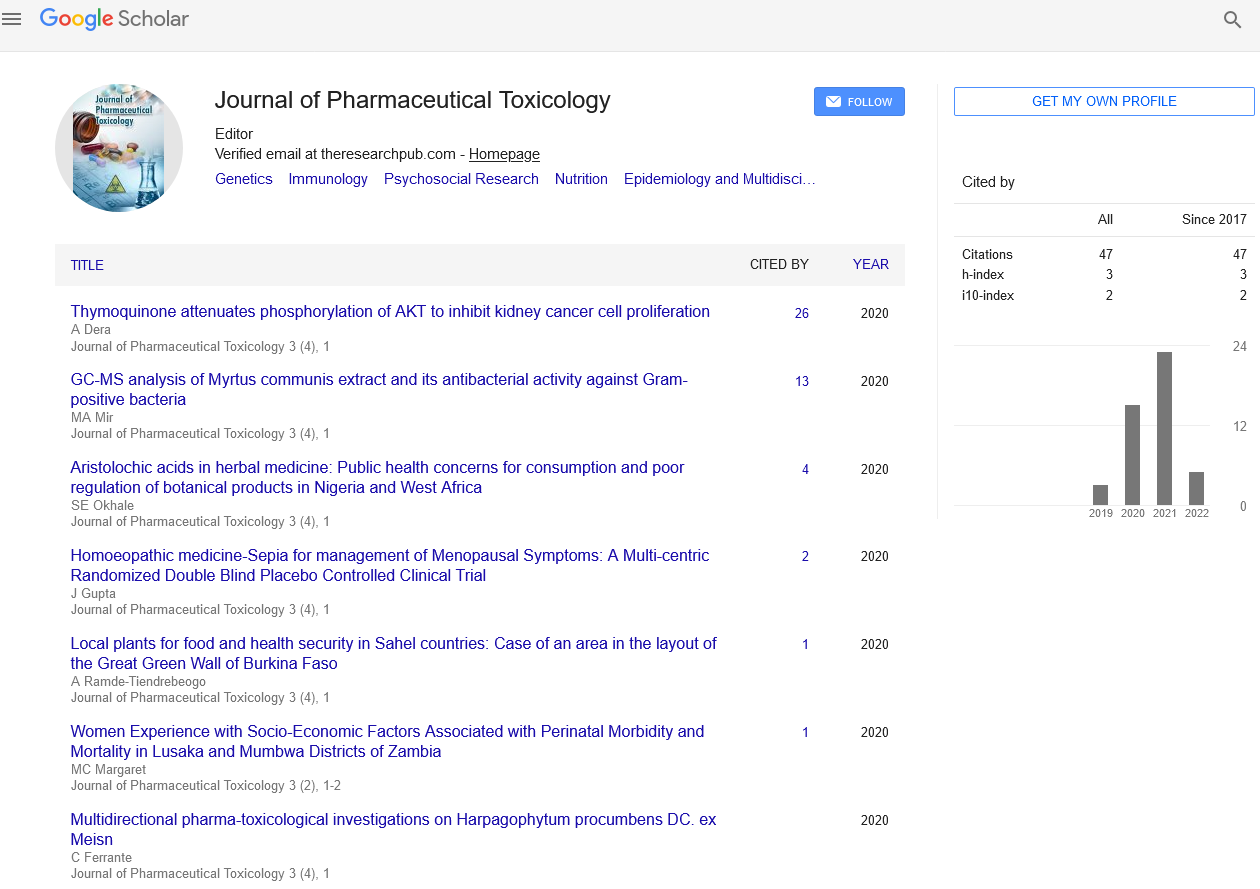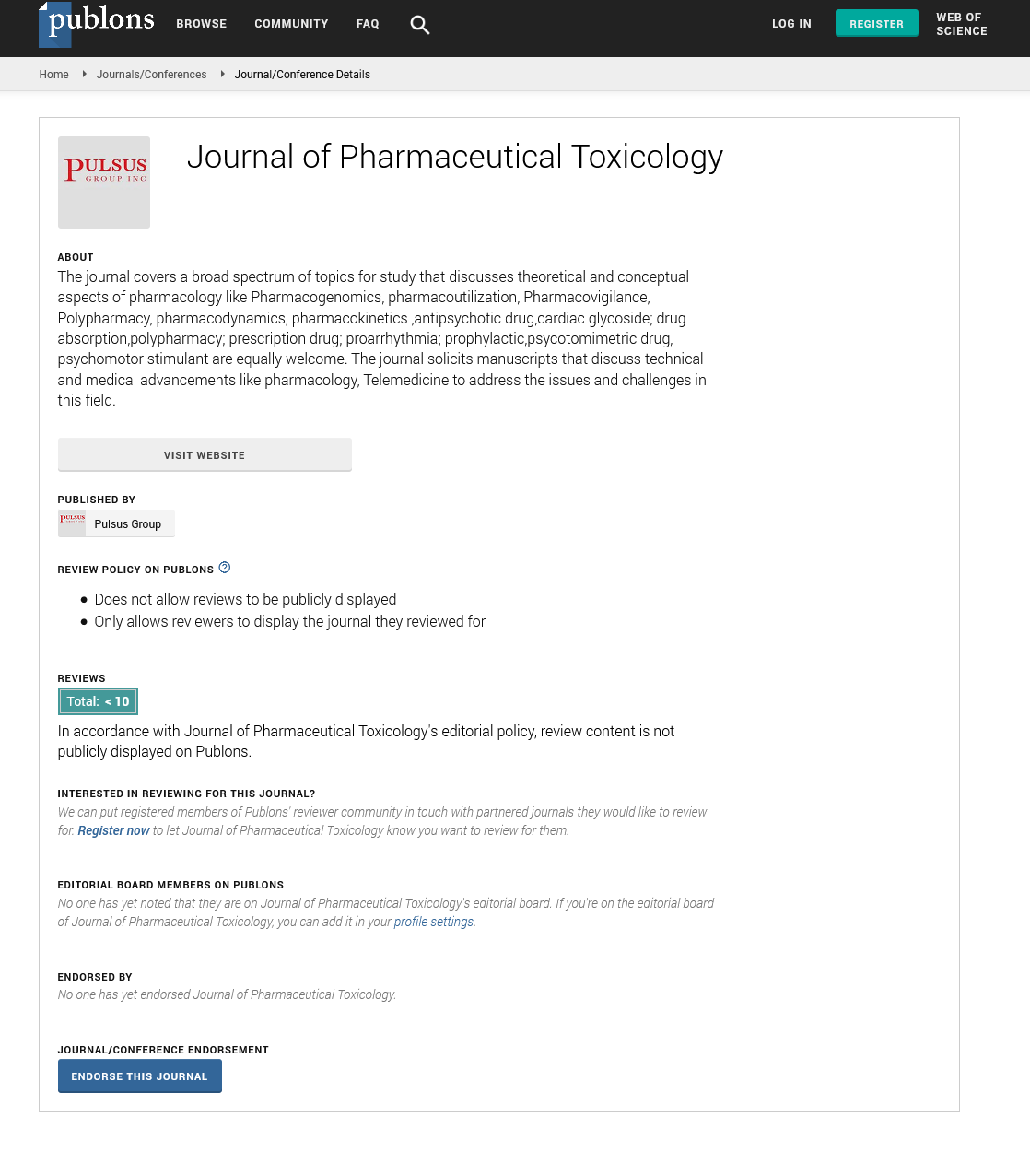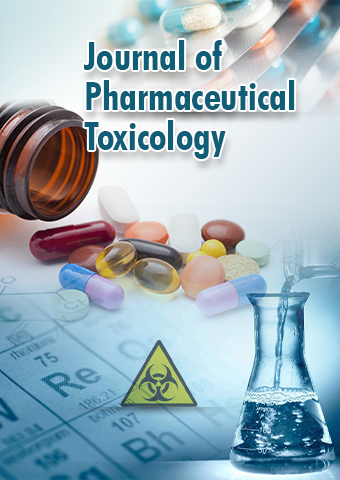Review Article - Journal of Pharmaceutical Toxicology (2023) Volume 6, Issue 2
Pharmaceutical Toxicology: Understanding the Risks and Benefits of Medications
Nikhil Aurora*
University Eklavya Colleage of Pharmacy, Tasgoan Department of Quality Assurance, India
University Eklavya Colleage of Pharmacy, Tasgoan Department of Quality Assurance, India
E-mail: nikhil.ar.23@gmail.com
Received: 03-April-2023, Manuscript No. jpt-23-94547; Editor assigned: 5-April-2023, PreQC No. jpt-23-94547 (PQ); Reviewed: 19-April-2023, QC No. jpt-23-94547; Revised: 22-April-2023, Manuscript No. jpt-23- 94547 (R); Published: 28-April-2023, DOI: 10.37532/jpt.2023.6(2).21-24
Abstract
Pharmaceutical toxicology is the study of the adverse effects of drugs on living organisms. While medications are intended to treat, cure, or prevent diseases, they can also cause harm if not used properly. The goal of pharmaceutical toxicology is to understand the risks and benefits of medications and to develop strategies to minimize their harmful effects. This article will explore the key concepts of pharmaceutical toxicology, including drug toxicity, dose-response relationships, drug interactions, and toxicity testing. We will also discuss some of the challenges associated with pharmaceutical toxicology, such as drug development, drug safety regulations, and ethical considerations.
Keywords
Diagnostic test • Covid-19 • Clinical trial • Pharmacology
Introduction
Drug toxicity refers to the harmful effects of drugs on living organisms. It can be caused by a variety of factors, including the dose, route of administration, duration of exposure, and individual characteristics of the patient. Some drugs can cause toxicity at low doses, while others require high doses or prolonged exposure. Drug toxicity can manifest in different ways, depending on the organ or system affected. For example, drugs that affect the liver can cause hepatitis, cirrhosis, or liver failure. Drugs that affect the heart can cause arrhythmias, myocardial infarction, or heart failure. Drugs that affect the nervous system can cause seizures, coma, or death [1].
Dose-response relationships describe the relationship between the dose of a drug and the magnitude of its effect. In general, the higher the dose, the greater the effect. However, this relationship is not always linear, and there may be a threshold below which no effect is observed. The dose-response relationship is important in pharmaceutical toxicology because it helps to determine the safe and effective dose of a drug. The therapeutic index is a measure of the safety of a drug and is calculated as the ratio of the dose that produces toxic effects to the dose that produces therapeutic effects. Drugs with a high therapeutic index are considered safer than drugs with a low therapeutic index. Drug interactions occur when two or more drugs interact with each other, resulting in an altered pharmacological response. Drug interactions can be beneficial or harmful, depending on the drugs involved and the patient’s individual characteristics. Beneficial drug interactions occur when two drugs produce a synergistic effect, meaning that their combined effect is greater than the sum of their individual effects. For example, combining a pain reliever with a muscle relaxant may provide greater pain relief than either drug alone [2].
Harmful drug interactions occur when two drugs produce an antagonistic effect, meaning that their combined effect is less than the sum of their individual effects. For example, combining an opioid with a benzodiazepine can increase the risk of respiratory depression and death. Toxicity testing is a crucial step in drug development, as it helps to identify potential adverse effects of drugs before they are approved for clinical use. Toxicity testing can be conducted in vitro (in cells or tissues) or in vivo (in animals).In vitro testing can provide valuable information about the mechanism of drug toxicity, but it has limitations in predicting the effects of drugs in living organisms. In vivo testing can provide more relevant information about the effects of drugs in living organisms, but it is expensive, time-consuming, and raises ethical concerns [3].
Discussion
Regulations play a critical role in ensuring the safety and efficacy of pharmaceuticals. The regulatory process involves several stages, including preclinical testing, clinical trials, and post-marketing surveillance. Preclinical testing involves testing the drug in vitro and in vivo to identify potential toxicity and establish a safe dose range. Clinical trials involve testing the drug in human subjects to evaluate its efficacy and safety. Post-marketing surveillance involves monitoring the drug’s safety and effectiveness after it has been approved for Pharmaceutical toxicology is a branch of toxicology that deals with the study of adverse effects caused by the use of pharmaceuticals on human health [4]. The adverse effects can range from mild to severe, and in some cases, can be life-threatening. Over the past few decades, there has been an increase in the use of pharmaceuticals for the treatment of various diseases and health conditions. However, this has also led to an increase in the incidence of adverse drug reactions (ADRs). In this article, we will discuss the impact of pharmaceutical toxicology on public health, and how it can be addressed.
Pharmaceutical toxicology encompasses a broad range of topics related to the study of the effects of pharmaceuticals on human health. This includes the study of pharmacokinetics, pharmacodynamics, toxic kinetics, and toxic dynamics of pharmaceuticals. Pharmacokinetics refers to the study of the absorption, distribution, metabolism, and excretion (ADME) of drugs in the body. Pharmacodynamics, on the other hand, refers to the study of the effects of drugs on the body, including their mechanism of action and therapeutic efficacy [5]. Toxic kinetics is the study of the ADME of toxicants, while toxic dynamics is the study of their effects on the body. Pharmaceuticals are designed to treat or prevent diseases and improve the quality of life for patients. However, the use of pharmaceuticals also comes with the risk of adverse effects, which can be detrimental to public health. ADRs are responsible for a significant number of hospital admissions, morbidity, and mortality worldwide. In the United States, ADRs are estimated to cause over 2 million hospitalizations and 100,000 deaths annually. This highlights the need for a better understanding of the safety profile of pharmaceuticals, and the implementation of measures to mitigate the risk of ADRs.
Regulatory authorities such as the Food and Drug Administration (FDA) play a critical role in ensuring the safety and efficacy of pharmaceuticals. Before a pharmaceutical product can be approved for use, it must undergo rigorous testing to determine its safety and efficacy profile. This includes preclinical testing in animal models, followed by clinical trials in humans. The results of these studies are then reviewed by regulatory authorities, who decide whether the product can be approved for use. Once a pharmaceutical product is approved, regulatory authorities continue to monitor its safety profile through post-marketing surveillance. This involves the collection of data on adverse events and ADRs associated with the use of the product. If significant safety concerns are identified, regulatory authorities may take action to restrict or withdraw the product from the market [6].
Healthcare professionals play a crucial role in identifying and managing ADRs. They are often the first point of contact for patients experiencing adverse effects associated with the use of pharmaceuticals. Healthcare professionals are trained to recognize the signs and symptoms of ADRs, and to report them to regulatory authorities through pharmacovigilance programs. In addition to reporting ADRs, healthcare professionals can also take measures to prevent them from occurring in the first place. This includes careful selection of the most appropriate pharmaceutical product for a particular patient, taking into account factors such as age, gender, and medical history. Healthcare professionals can also educate patients on the proper use of pharmaceuticals, including the risks and benefits associated with their use. The Importance of Education and Research in Pharmaceutical Toxicology Education and research are critical in advancing the field of pharmaceutical toxicology and improving public health. This includes the development of new methodologies for the assessment of the safety and efficacy of pharmaceuticals [7].
Pharmaceutical toxicology is essential in drug development as it helps to identify potential risks associated with the use of drugs. It involves the evaluation of the safety, efficacy, and pharmacokinetics of drugs in both animals and humans. This process is critical in the development of new drugs as it helps to ensure that drugs are safe and effective for human use. Toxicological studies are carried out at different stages of drug development, from the preclinical stage to post-marketing surveillance. Preclinical studies involve the evaluation of drugs in animals to identify potential toxic effects. This stage helps to determine the safe starting dose of the drug and the optimal route of administration. The results of preclinical studies are used to determine whether a drug is safe enough to proceed to clinical trials.
Clinical trials involve the testing of drugs in humans. The first phase of clinical trials involves a small number of healthy volunteers to evaluate the safety and pharmacokinetics of the drug. Subsequent phases involve larger populations of patients to evaluate the efficacy of the drug. Toxicological studies are carried out during clinical trials to identify any adverse effects of the drug. Post-marketing surveillance involves the monitoring of drugs after they have been released into the market. This stage helps to identify any adverse effects that were not detected during preclinical or clinical studies. Pharmaceutical companies are required to report any adverse effects of their drugs to regulatory agencies. Regulatory agencies play a critical role in pharmaceutical toxicology. They are responsible for ensuring that drugs are safe and effective for human use. Regulatory agencies review the results of preclinical and clinical studies before approving drugs for use [8]. They also monitor drugs after they have been released into the market to ensure that they continue to be safe and effective.
In the United States, the Food and Drug Administration (FDA) is the regulatory agency responsible for the approval of drugs. The FDA reviews the results of preclinical and clinical studies to determine whether a drug is safe and effective for human use. The FDA also monitors drugs after they have been released into the market and can take action if a drug is found to be unsafe. Pharmaceutical toxicology plays a crucial role in public health. The use of drugs has increased significantly over the years, and the safety and efficacy of these drugs are critical to public health [9]. Pharmaceutical toxicology helps to ensure that drugs are safe and effective for human use. Toxicological studies have helped to identify the adverse effects of many drugs. For example, the thalidomide tragedy in the 1960s resulted in the birth of thousands of children with birth defects. Thalidomide was used to treat morning sickness in pregnant women, but it was later discovered that it caused severe birth defects. This tragedy led to the establishment of stricter regulations for the approval of drugs [10].
Conclusion
In conclusion, pharmaceutical toxicology plays a crucial role in drug development and public health. It helps to ensure that drugs are safe Pharmaceutical toxicology has also helped to identify drug interactions that can be harmful to patients. Many drugs interact with other drugs, and these interactions can lead to adverse effects. Toxicological studies help to identify potential drug interactions and provide guidance on the safe use of drugs. Pharmaceutical toxicology is a branch of toxicology that deals with the study of the adverse effects of drugs and other chemicals on living organisms. It plays a crucial role in drug development and ensures the safety and efficacy of drugs before they are released into the market. This article explores the impact of pharmaceutical toxicology on drug development and public health.
Conflict of Interest
None
Acknowledgement
None
References
- Sun J, He WT, Wang L et al. COVID-19: epidemiology, evolution, and cross-disciplinary perspectives. Trends Mol Med. 26,483 (2020).
- Li Q, Guan X, Wu P et al. Early transmission dynamics in Wuhan, China, of novel coronavirus-infected pneumonia. NEJM. 382,1199-1207 (2020).
- Mohebali M. Visceral leishmaniasis in Iran: review of the epidemiological and clinical features. Iran J Parasitol. 8,348-358 (2013).
- Mohebali M, Hajjaran H, Hamzavi Y et al. Epidemiological aspects of canine visceral leishmaniosis in the Islamic Republic of Iran. Vet Parasitol. 129,243-251 (2005).
- Shafiei R, Mohebali M, Akhoundi B et al. Emergence of co-infection of visceral leishmaniasis in HIV-positive patients in northeast Iran. Travel Med Infect Dis. 12,173-178 (2014).
- Topno RK, Das VNR, Ranjan A et al. Asymptomatic infection with visceral leishmaniasis in a disease-endemic area in Bihar, India. Am J Trop Med Hyg. 83:502-506 (2010).
- Zhou P, Liu Z, Chen Y et al. Bacterial and fungal infections in COVID-19 patientsn. Infect Control Hosp Epidemiol. 4,1124-1125 (2020).
- Viney ME, Graham AL. Patterns and processes in parasite co-infection. Adv Parasitol. 82,321-369 (2013).
- Sundar S, Rai M. Laboratory diagnosis of visceral leishmaniasis. Clin Vaccine Immunol. 9,951-958 (2002).
- Dalgiç B, Dursun I, Akyol G et al. A case of visceral leishmaniasis misdiagnosed as autoimmune hepatitis. Turk J Gastroenterol. 16,52-53 (2005).
Google Scholar, Crossref, Indexed at
Google Scholar, Crossref, Indexed at
Google Scholar, Crossref, Indexed at
Google Scholar, Crossref, Indexed at
Google Scholar, Crossref, Indexed at
Google Scholar, Crossref, Indexed at
Google Scholar, Crossref, Indexed at
Google Scholar, Crossref, Indexed at


